


september 2024 issue 8 • volume 51
7607 NW Prairie View Rd, Platte Woods, MO 64151-1544 816-599-7777 • FAX: 816-599-7782 www.shorthorncountry.net




september 2024 issue 8 • volume 51
7607 NW Prairie View Rd, Platte Woods, MO 64151-1544 816-599-7777 • FAX: 816-599-7782 www.shorthorncountry.net
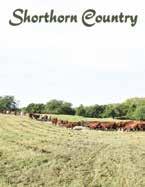
Contract Rates And Discounts:
on
Contract rates require advertising in all 11 issues per year with a business card ad. Business card price is pre-paid at the beginning of the calendar year or pro-rated if started after the first issue of the year. Contract (11x) rates do not apply for any sale advertising. Contract advertisers must run the business card ad in every issue. Contracts will run by calendar year. No agency commissions are allowed.
Online Sale Packages & Sale Catalogs
Contact us about your upcoming Online Sale or Sale Catalogs for marketing options and pricing.
Don Cagwin, publisher
Amy Sampson, managing editor/creative director 816-599-7777 • amy@shorthorncountry.org
Amanda Cagwin, accountant • amandacagwin@yahoo.com
Advertising Representatives
Cindy Cagwin-Johnston 217-452-3051 • cagwincattle@casscomm.com
Darryl Rahn 217-473-1124 • drahn@casscomm.com
Jay Carlson, Carlson Media Group, LLC 913-268-5725 • Jay@carlsonmediagroup.com
Advisory Council
Montie Soules, ASA representative Don Cagwin, Durham Management Co.
Subscriptions
US: 1 year- $24 • 2 years - $38 • 3 years - $52 1 year US First Class - $54/year Canada: 1 year- $60 • 2 years - $110 • 3 years - $130 Other Foreign: 1 year- $120 • 2 years - $220 • 3 years - $300
SHORTHORN COUNTRY
(ISSN 0149-9319) Published monthly by the American Shorthorn Association, 7607 NW Prairie View Rd., Platte Woods, MO 64151. Subscription rates are $24.00 for 1 year, $38.00 for 2 years, and $52.00 for 3 years in the U.S.; $60.00 for 1 year,

POSTMASTER:


American Shorthorn Association
7607 NW Prairie View Rd. Kansas City, MO 64151-1544 816-599-7777 • www.shorthorn.org
Montie D. Soules, asa executive secretary/CEO montie@shorthorn.org
Matt Woolfolk, director of performance programs; performance data & commercial acceptance • matt@shorthorn.org
Heather Lange, director of office operations; customer service, registrations & DNA • heather@shorthorn.org
Shelby Diehm, director of youth activities; marketing & communications • shelby@shorthorn.org
Cassie Reid, director of shows & events; customer service specialist cassie@shorthorn.org
Wade Minihan, director of shows & member communications; customer service specialist • wade@shorthorn.org
Carrie Land, customer service specialist • carrie@shorthorn.org Accounting • accountmgr@shorthorn.org
September
Sept. 2 ASA Office Closed - Labor Day
Sept. 3 All ballots due in ASA office for electing delegates
Sept. 8 Washington State Fair Regional Show
Sept. 10 American Royal Entry Deadline & Junior Ownership Deadline
Sept. 13 Kansas State Fair Regional Show
Sept. 15 Amarillo Tri State Fair & Rodeo Regional Show
Sept. 15 American Royal Late Entry Deadline (increased fees)
Sept. 20 World Beef Expo Regional Show
Sept. 21 KILE Late Entry Deadline
Sept. 28 Tulsa State Fair Super Regional Show
October
Oct. 3 Annual Meeting Registration Deadline (fees increase Oct. 4)
Oct. 5 KILE - National Shorthorn & ShorthornPlus Show - 8:00 am
Oct. 6 KILE - Junior Shorthorn & ShorthornPlus Show - 8:00 am
Oct. 8 NAILE Entry & Junior Ownership Deadline
Oct. 13 Northern International Livestock Exposition Super Regional Show
Oct. 15 NAILE Late Entry Deadline
Oct. 24 American Royal - Junior Shorthorn & ShorthornPlus Show - 9:00 am
Oct. 25 American Royal - National Shorthorn & ShorthornPlus Show - 9:30 am
ASA Board of Directors
Toby Jordan, president 219-819-4603
Lee Miller, vice president 330-231-6834
John Sonderman, executive director 402-641-0936
Jeff Bedwell, 580-822-5590
John Russell, 832-588-8604
Rick Osterday, 605-281-1175
Mark Gordon, 217-737-7905
Cory Bollum, 507-279-0480
Tyler Cates, 765-576-0035
Shorthorn Foundation
Bill Rasor, president American Junior Shorthorn Association
Haylee Ferguson, president National Shorthorn Lassies Tawana Holland, president
Hilton Kansas City Airport
Kansas City, MO
October 25 & 26, 2024
Friday, Oct. 20
5:00 pm to 8:00 pm - Breeder Social at the ASA Office
Saturday, Oct. 21
9:00 am - Annual Meeting
Social time after Annual Meeting
Noon - Awards Luncheon
- Presentation of Awards
• Century Club
• Performance Awards
• 2023-2024 Show Awards
• Heritage Award
• Merit Award
• Builder of the Breed Awards Reception to follow at the Hotel
Make room reservations and register for the event on shorthorn.org by October 3rd.
Early Registration Fee, $75
Registration Fee After October 3, $100
Oct. 25 ASA Annual Meeting Breeder Social at the Office in KC
Oct. 26 ASA Annual Meeting & Awards Banquet - Hilton Kansas City Airport
November
Nov. 1 Inventories sent for 2025 WHR Assessments
Nov. 16 NAILE - Jr. ShorthornPlus Heifer Show
Nov. 17 NAILE - Jr. Shorthorn Heifer Show
Nov. 18 NAILE - Super National Shorthorn & ShorthornPlus Bull and Female Show
Nov. 20 Cattlemen’s Congress Entry Deadline
Nov. 20 NWSS Entry Deadline
Nov. 28-29 ASA Office ClosedThanksgiving and day after December
Dec. 1 Cattlemen’s Congress Late Entry/ Subsitution Deadline & Junior Breeding Heifer Ownership Deadline
Dec. 1 NWSS Junior Breeding Heifer Ownership Deadline
Dec. 10 NWSS Late Entry Deadline
Breeders can now send and are encouraged to send DNA samples directly to Neogen for testing rather than sending to the ASA office. Starting July 1, 2023, a manual processing fee will be incurred for those samples sent to the ASA office for preprocessing.
3 things will be required to send samples in for testing: 1. A registration (or recorded “U”) number for each tested animal
2. A paper copy of the finalized testing form, (emailed from staff, description below) which includes the Neogen order number
3. A barcode number for each animal tested
Breeders can queue up animals for testing in DigitalBeef and select which sample types they have, as well as which tests they want. Once the form is submitted, staff will process the testing request and get an order ID # from Neogen. A finalized printable PDF of the submission form will be emailed to you to print, sign and send to the lab with samples. Checks/ payments are still made to the ASA. Once staff approves the testing request, the breeder’s DigitalBeef account is billed accordingly.
Monday - Thursday 8:00 am to 4:30 pm Friday 8:00 am to 2:00 pm
Central Time Zone
(ASA Staff Meeting Tuesdays 10:00-11:00 AM)





The Shorthorn Summer Symposium, themed “Putting Your Herd in the Winner’s Circle,” was held at the state-of-the-art Blue Grass Stockyards in Lexington, Kentucky on July 18, 19, and 20th. This premier facility provided the perfect setting for a dynamic and educational event. We owe a debt of gratitude to Jim Akers for generously allowing us to use this exceptional venue.
The symposium drew over 100 attendees, all eager to gain insights from a distinguished list of speakers who are highly recognized in the industry. Special thanks goes to the ASA staff for their hard work in making this event a success. Cassie Reid coordinated the activities and venues, with a particular shoutout to Matt Woolfolk. His meticulous planning and thoughtful selection of topics and speakers were instrumental in the event’s success.
One of the conference highlights was the “Insider’s Perspective of the Thoroughbred Horse Industry,” which allowed breeders to draw parallels between the horse industry and their own. This session provided fresh perspectives and innovative ideas that attendees found invaluable. The tour of Boyd Beef Cattle was another standout feature, impressing all who attended. Additionally, the practical session on “How to Take a Good Picture” proved to be highly beneficial, equipping participants with essential skills for effectively showcasing their herds.
There were so many outstanding speakers and valuable pieces of information that it’s impossible to list them all here. For a more comprehensive overview, attendees and readers can refer to the 16-page pullout catalog in the center of this Shorthorn Country issue,
which includes a dedicated page for each speaker. Each page review comes with a QR code linking to a video of the presentation, allowing for deeper engagement and review. I do want to single out the report on indexes that were presented at the Symposium. Make sure to find that page and watch the video, as well as read the article in this issue written by Matt. This extensive review and report of the conference are generously sponsored and paid for by Merck Animal Health. A huge thank you for their support!
Other popular tours included visits to the Castle and Key Distillery and Claiborne Farms, both of which were hits with attendees. The in-depth knowledge shared by the speakers, ranging from genetics and genomics to marketing, was some of the best I have ever experienced. The symposium was packed with information for our beef
cattle industry and Shorthorn breeders, preparing us for future success.
I challenge everyone to take the time to read through the written reviews from staff and attendees and then watch the videos at your leisure. Take advantage of these tremendous speakers filled with information, knowledge, and expertise that is hard to find in any books or handouts. The Shorthorn Summer Symposium was a resounding success, offering a wealth of knowledge and practical skills that will undoubtedly benefit Shorthorn breeders looking for success in the future!









During the Shorthorn Summer Symposium, attendees that came to Kentucky got a dose of the sector of agriculture that makes the area famous: Thoroughbred horse breeding. The group welcomed Price Bell of Mill Ridge Farm to the program to provide his perspectives on the industry he works in daily. Mill Ridge is one of Lexington’s most prominent breeding farms, as they stand stallions for public breeding, prepare young horses for auction, foal out mares for themselves and for clients, and offer a breeding consulting service as well. Winners of all three Triple Crown races and other championship races are products of the Mill Ridge program. While Price was with us, we touched on all these facets of their business. For this article, the focus will be on the one I found most fascinating: the selection of stallions for the broodmares.
What I appreciated most about our time spent with Price Bell was that his responses to questions were thorough and genuine. He could have easily kept it simple and moved on to the next topic, but he chose to dive in and expose how he and others think when making breeding decisions annually. From that discussion, there were three overarching methods of breeding strategy that Bell outlined.
Breeding Similar Kinds
As Price outlined in this situation, this is the line of thought of breeding horses that performed or produced in similar types of races to try and maximize those specific abilities. If a mare that won or produced winning foals in races a mile or longer on the dirt, then the goal is to find a stallion that matches that profile as well. If all goes according to plan, the resulting horse should be a runner with a plethora of stamina, suited for the longer two-turn races on the dirt track that are
so popular in the United States. Whether it’s speed or stamina traits, turf or dirt racing, breeders with this philosophy are trying to emphasize those traits from both sides of the pedigree.
Breeding Different Kinds
You’ll also find the opposing school of thought to what I just outlined prevalent in the Thoroughbred breeding industry. In this case, if the mare is a producer of stamina-based horses, they might be able to run all day but don’t do it very quickly. So, finding a stallion whose progeny have some zip and quickness would be a priority. The hope is to hit the best traits of both sides of the pedigree to create a fast horse with stamina.
Breeding on “The Physical”
Another popular breeding philosophy is attempting to correct the physical aspects of a mare with the stallion selected for breeding. Breeding a smaller mare to a bigger stallion, or a plain, nondescript mare to a stud with a striking appearance to make a foal that is more ideal in its conformation than its mother. I’m not an expert on the physical characteristics of a horse, but the philosophy of making selection based on attempts to improve a flaw is something I can sure understand. Why are there several breeding philosophies in the Thoroughbred world that all look different to each other on paper? Because there are buyers for all these types of horses. If you walk the grounds of Fasig Tipton Sales (another Symposium tour stop) during a yearling sale, you will find folks studying the offering with interest in all these processes. Pedigree experts, mare production analysts, and appraisers of the physical specimen are all commonly found. If you can impress the right person with the right client, a big pay day could be looming.
As I sit back and think about the ideas
Bell laid out for us, I certainly think all these strategies (and even a combination of all of them together) are welcomed in the seedstock cattle industry. We breed cattle that excel for the same traits often to keep pushing them forward, whether it be growth, calving ease, carcass merit, or anything else you feel like naming. The process of “corrective mating”, as mentioned by fellow Symposium guest Brian McCulloh, is often used in our business and is very much like breeding speed to stamina, or other differing kinds. And of course, we all incorporate the physical characteristics of our cattle when we select which bull goes to which cow. And what is our goal with employing any of these ideas? To get paid well for our cattle!
Another similarity between our breeding industries was so eloquently described early in the program by Dr. Troy Rowan: dumb luck. You may think you know where the next good one is coming from, but sometimes, genetics disagree with you. Throughout our time in Lexington, we heard of low-cost young horses who went on to be champions. Seattle Slew in the 70’s was a $17,000 horse that won the Triple Crown and became an elite sire. We also heard more than once about The Green Monkey, a $16 million (not a typo) two-year-old who was unable to outrun his shadow on the racetrack and deemed infertile in his breeding career. We’ve all seen the same thing happen in our pastures, just with a few less zeros on the value of our calf crops. If you think we as beef producers have nothing in common with the world of the wealthy breeding prized racehorses, I will disagree. The roadmap we are on as stock breeders is similar, they are just driving a faster vehicle.


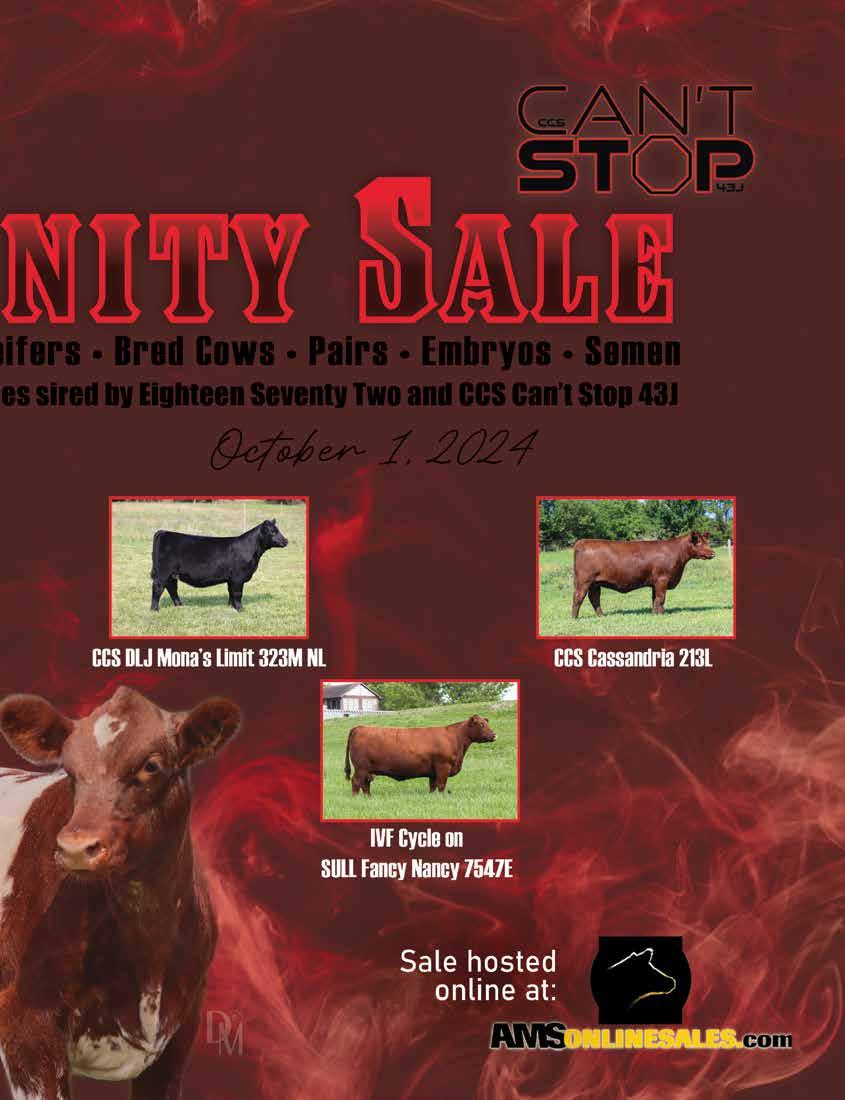


Many regional and super regional shows have wrapped up in the last couple months, meaning our 2024-2025 Show Season is well underway!
As our office receives results following each of the shows, we will work to upload the points into DigitalBeef. Show points can be tracked using DigitalBeef throughout the year. The “Show Points” page can be found on the left-hand menu as the last option. Follow the screenshot below to get the most out of this tool.
Ownership of these animals will display online as the current owner in DigitalBeef, which may differ from the owner on show day. When we figure show awards at the end of the year, we will recognize the respective owners from throughout the show season.
As a reminder, regional and national show awards for the year are figured on animals attending at least two point shows in a region.
Our first national shows for the year
are the Keystone International Livestock Exposition (KILE) and the American Royal in October.
At print time, the regular entry period has passed for KILE, late entries remain open through September 21st. Wade and I both anticipate seeing an uptick in entries following our east coast Junior Nationals this year! Kicking off our national show season in Harrisburg is a great jumping block from Junior Nationals just down the road in Timonium. We hope to see you there!
Rounding out the October shows, the American Royal entries remain open through September 10th, late entries will close September 15th. This year, the annual meeting and awards luncheon will be held in conjunction with the American Royal; rounding out the week on Saturday, October 26th. During the awards luncheon, we will recognize award winners, including the 2023-2024 Show Season Winners. Find
the detailed annual meeting schedule and information in the news and notes section of this issue.
American Royal Stalling: Please send stalling requests for the American Royal to cassie@shrthorn.org prior to September 16th. For this show, breed staff coordinate all requests so that we can stall all entries. Knowing these requests in a timely manner allows us the best opportunity to serve you.
As we dive into fall, remember these key factors to success for the show season:
• Register and transfer cattle prior to entry deadline. For various reasons, registrations may take you time. Starting this process early allows you the time needed to have your ‘ducks in a row’.
• If you plan to participate in the E.D.G.E. Show at Cattlemen’s Congress, those animals must:
o Have birthweight and weaning weight recorded in DigitalBeef
o Have a 100K Genomic testing sample submitted and received at the lab by November 1.
As always, if you have any questions regarding upcoming shows, reach out to Wade or Cassie!
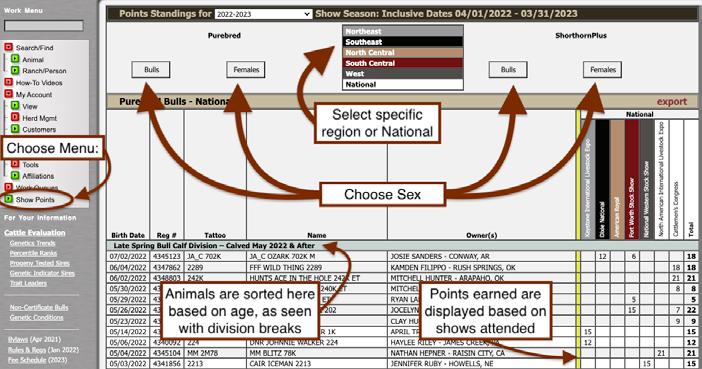





Wade Minihan director of shows & member communications; customer service specialist
We are excited to celebrate another year at our annual meeting which will be held Saturday, October 26, 2024. There will be a social held at the ASA Office the evening of Friday, October 25, 2024, to kick off the celebration and we invite all who can attend to join us.
Many of you have received your ballot for the election of 2024 Delegates this year by email, as well as by the US
postal service, as we will try in the utilize emailing more documents as we move forward in a more environmentally friendly decision. This helps us get those important documents out faster, and for us to receive them back in our office sooner. Those ballots are due back to the office September 3,2024.
Once the delegate ballots are collected and tallied, a letter and email will be
sent out to those individuals elected to represent their state at the annual meeting. Please be watching your email and mailbox for that information.We ask that you confirm or decline your ability to represent your state at the annual meeting in a timely manor as we have a tight turnout to post the list of those Elected Delegates in the October issue of the Shorthorn Country.



What an amazing start to The Summer Symposium by touring the Castle & Key Distillery. Shorthorn breeders from across the states were able to delve into the craftsmanship that defines Castle & Key’s legacy, exploring the intricate processes behind their acclaimed bourbons and gins. Experts shared their expertise on distillation techniques, flavor profiles, and the evolving landscape of spirits production.
We were able to dive deep into the history of the distillery that was originally established as the Old Taylor Distillery in 1887 by Colonel E.H. Taylor Jr. The distillery was designed by prominent
architectural firm of the time, and it quickly became known for its impressive architecture and grandeur, resembling a castle, hence its nickname “Castle & Key.” Tours of the distillery offer visitors a chance to learn about its history, architecture, and bourbon-making process, further enhancing its role in Kentucky’s bourbon tourism industry. Castle & Key Distillery represents more than just a bourbon producer; it stands as a testament to the enduring legacy of Kentucky’s bourbon heritage and the vision of its founders. By preserving the historic site and producing exceptional bourbon, Castle & Key continues



to contribute to the rich tapestry of Kentucky’s bourbon history.
After the tour, the evening turned into a social affair sponsored by Aegerter Marketing Services, Inc., where cattle enthusists were able to catch up with old friends, and new connections were made. Surrounded by a buatiful scenory, we mingled over crafted cocktails and indulged in hors d’oeuvres. Laughter echoed through the historic halls, blending the spirits of the past with the vibrant energy of the present, creating an unforgettable evening at Castle & Key Distillery.



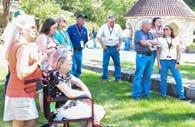




Chip
The Summer Symposium opening session with Chip Kemp, Director of IGS Commercial and Industry Operations and Montie Soules, Executive Secretary of the American Shorthorn Association, provided our attendees with inciteful industry tips to prepare their operation for the future. With seedstock businesses ever changing, the data driven industry we operate in is more eager than ever to succeed in data evaluation.
When specifically asked what Shorthorn breeders can do for the future, Kemp said, “We cannot do the things we’ve always done and expect different outcomes.”

Soules presented Kemp with questions digging deeper into the future of the seedstock industry. Starting off the session, Soules asked, “Will the access to genetics and selection change?” Kemp encouraged breeders to work together, stating that private genetic evaluations, which try to bring everything inhouse, simply do not present verifiable data. Having cooperative programs allows for a checks and balances of applicable data. By reporting all the data a breeder can, this allows the association to “row in the same direction”, so that we can all help toward achieving breed objectives. Collaboration is key in our industry. The beauty of a company such as IGS, is that by collaborating and working together we magnify the impact that any one of us would have on our own. Quite simply, we are better together.


Kemp encouraged our breeders to help the next person in this business be more successful at this craft than the ones before them. Everyone has their own opinions and although they each are valuable, Kemp encourages you, “that if you disagree, disagree with such vigor you do your homework.”

“We need all the data we can record; we need to work together as a breed.”

• Most small-scale dairy operations sell more beef cattle than large-scale beef cattle operations.
• Breeders know best; breeders live it every day, feeling their own personal pressures.
• Collaboration is the only plausible choice and will become even more vital in the future.
• Jobs will help youth stay in this business. We should ensure that youth not only have the opportunity, but the interest to stay in the business.







Dr. Troy Rowan, University of Tennessee
“How much is accuracy worth to you?” Dr. Troy Rowan asked attendees at the Summer Symposium. Would you use a measuring tape if it was broken? No. So why are we using EPD’s that may not be accurate?
Dr. Rowan highlighted some benefits of genomics that might sound familiar. He stated, “Having a correct pedigree in a breed is really, really important”. IGS still relies on the pedigree connections within a breed. Not only can we obtain parentage markers from genomics, but we can also test for genetic defects and use those results to further assist in the genetic selection process.
Further, Rowan emphasized the risk involved in bull selection, and how the optimum tool for mitigating risk is genomics. Genomics ease the burden of the guesswork that can come when selecting the right sires for your operation. Rowan mentioned that the
ultimate goal as seedstock producers should be consistent genetic progress.
In attendance of the session, Cary Gilman (Gilman Shorthorns, Stuart, Iowa) had some insightful takeaways.
• “EPDs are risk management for buyers.” I have never heard them described that way. The light bulb went off, that quote is spot on. Producers, including myself, use EPDs to avoid problems or train wrecks. Genomics allow us to clear the fog and look around corners with much more accuracy to avoid those problems. It’s like having insider information when you are trying to figure out how to invest your money in the market.
• Genomically enhanced EPDs give us one whole calf crop of accuracy in fine tuning the EPDs. That is huge when trying to select where your money should be invested. Genomics allow us to speed up genetic progress, plus more accurately and profitably make selections on what breeding stock to use or offer for sale. Genomic enhanced EPDs are also a useful tool in making mating decisions.



the country, they are a useful tool that takes environmental differences out of the picture when actual performance data can’t.
• Selecting the right bull is half of your herd’s future. Selecting the wrong bull can be all of your herd’s future. Genomic enhanced EPDs are the best tool we have to avoid making mistakes. It’s the closest thing there is in the cattle business to having a crystal ball.
For access to Dr. Troy Rowan’s whole presentation on Why Seedstock Producers Should Care About Genomics and Genetic Evaluation, follow the QR code below!

• EPDs or genomic enhanced EPDs are not the be all end all answer. Phenotype and common sense when making breeding decisions are still very important. In a small breed like ours that is spread out all over




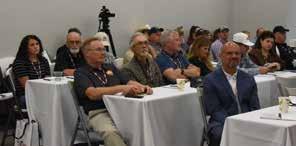
Eric Grant, Grant Company
There are a million approaches to how you market and advertise your herd. Eric Grant of Grant Company, St Joseph, Missouri joined us in Kentucky to share how marketing is more than just ads.
“The Shorthorn breed is in a really strong position right now,” Grant said. “It is on the cusp of even greater growth. But it is the responsibility from a marketing and advertising standpoint on each breeder’s shoulders to ensure it continues to grow in the right ways.”
Based on research gathered by Grant from four different Shorthorn operations, Shorthorn bull prices have gone up 44% since 2019. He went on to say there have been 32% more bulls sold


and an 89% increase in bull revenue. The custom semen collection is also at the highest level in a decade. These percentages would trend in the opposite direction if there wasn’t an interest in Shorthorn genetics.
Grant stated that the industry used to be in a one-ad mindset. One print ad mindset. You do one ad or take one photo and walk away. It isn’t that way anymore.
“With marketing, it is the sustained effort that matters,” Grant said. “Not the one-shot wonder.”
Artificial intelligence is a little terrifying. Don’t use it on photos, they need to be authentic. When creating a social media plan, it is important to stay consistent and plan to follow a pattern.
The value of good photos, face-to-face interaction, and continuous marketing are all important to growing your business and brand. All the effort over time will ensure success in marketing. You can’t do things once and expect great results.




• You can’t do squat without good photos. “We call a collection of photos hay in the barn,” explained Grant. “If you don’t have good photos, you can’t market. Just like if you don’t have hay, you can’t feed your cattle. You need to have good photos.”
• You can’t build value without good information. Basic simple interaction creates good value. Business card = contact information = value
• Every calf is a story. that you tell continuously to your customers. Think as more than the whole herd but the individual animal. Create value around that calf. Share the information with your customers so they feel connected.
• Make it about the CUSTOMERS, not you. Share their experience in working with you. People like the stories, they follow the stories.
• It’s not print versus the world. You can’t abandon print. It anchors everything together. If you have the print assets, you have social media assets.
• Hire the right ‘kid.’ So many kids are looking for opportunities to add to their portfolio or add experience. Find one that can do social media and wants to help you grow your brand.
• Every interaction can reap rewards. Make a point to introduce yourself to someone you don’t know. Don’t huddle with people you know at events you attend. You don’t know how it could change your life.
• Know your market. Find your niche and stay there.
• What you do must add value and solve problems.
• Follow up after the sale and find out how the cattle did. Make it right and use success stories.
• Understand your obligation to others.

Price Bell dove into the history of the thoroughbred horse breed and how it began. Bell enlightened listeners on different purposes that thoroughbreds serve and some of the ins and outs of the thoroughbred horse breed. “He had excellent history of the industry and Mill Ridge” stated Symposium attendee and Tennessee Shorthorn Producer, Kevin Ferguson.
A great number of horses that are brought up on Mill Ridge’s operation are sold as yearlings where they are then taken to be trained. They are trained to compete on the racetrack and once they have completed their racing career, they are brought back to be used for breeding or trained for a second career. These second careers are often athletic disciplines. Some horses may become jumpers or dressage, while others may even become equine assisted therapy horses.
Horse producers are trying to raise fast horse; cattle producers are trying to raise fat cattle, but it’s a connection between the two that proves our industries are more similar than we realize, although the end product may be a bit different. Both try to educate people who misunderstand the purpose that we serve for the well-being of the animal. “Price Bell stressed the importance of engaging with neighbors, especially when Mill Ridge added tours of their farms” was something attendee Kevin Ferguson took away from the presentation.
Price dove into what is considered when making the next ‘great one’. He discussed the different factors when mating thoroughbreds, and stated that everyone has their own philosophies that they follow when making breeding decisions. Ferguson stated that “there was excellent discussion of mating decisions. They evaluate the quality of the mare, and they evaluate the stallion’s qualities that would compliment the mare. The variation in the stud fees to select for a proven mare versus an unproven mare was interesting.” All thoroughbreds must be live covered as it is written in the thoroughbred rule book. Some may also call this tradition. Price went on to state the “Tradition for the sake of tradition has been detrimental.” This brought him into discussing the gene pool and with being able to only live cover this keeps








the cost of stud fees up and the dates of the breeding season to set time frame. Thoroughbred breeding season is from of the middle February to the beginning of July.
Bell brought up many interesting factors that are used in the thoroughbred business, that many in the cattle business might find interesting. Bell noted the importance of customer service and having a product to sell, which were two things that stood out to Ferguson. Ferguson also voiced that “it was interesting, the parallels between the Thoroughbred industry and the purebred breed cattle industry. It appears to me that the primary players in each, operate in different tax brackets.”
Learn more and listen for yourself with the QR code shown below.



During our genetics and performance themed breakout session, we received presentations from Dr. Troy Rowan of the University of Tennessee and Matt Woolfolk of the American Shorthorn Association.
Dr. Rowan spoke first and aimed to answer a question many seedstock producers ponder: what are my

customers looking at? Using eye tracking technology and other tactics, we may have an answer. First, Dr. Rowan explained that customers that use EPDs more accurately assign value to an animal. That being said, when a customer is given a catalog, they evaluate a photo first, spending the most time on an animal’s head before moving on to


study the EPDs, especially the animal’s index values.
Using this research Dr. Rowan draws a few conclusions:
- Layout matters in a catalog.
- Genomic test your cattle, adding accuracy to EPDs.
- Indexes are worth printing in your catalog.
The information Dr. Rowan presented included fascinating mapping of where a potential bull buyers eyes looked at specific parts of catalogs and ads. It helped to really emphasize what were the most important details in catalogs to have absolutely correct and favorable. Matt Woolfolk’s talk included the actual dollar advantage of crossbreeding and the improvements of some specific traits to expect with cross breeding systems.

Matt Woolfolk followed Dr. Rowan’s presentation, speaking on hybrid vigor and its money-making potential.
Woolfolk began with a summary of bull sale data in a ten-state region where Shorthorn cattle are prominent. In that area, over 30,000 Angus bulls were sold in a two-year span compared to just 700 Shorthorns. This presents an opportunity to Shorthorn breeders, as those Angus will sire many daughters. If a producer wants to continue to utilize heterosis, that is the market space for Shorthorn bulls. Woolfolk also rallied breeders stating, “It’s not about the 30,000 Angus bulls and competing with them, it’s about making our 700 bulls the BEST they can be.”
Woolfolk continued the discussion with information on the impacts of hybrid vigor on cattle performance, ways to implement Shorthorn genetics into a
commercial crossbreeding program, and an economic example of how utilizing heterosis can impact the revenue of a commercial cattle operation.
“A commercial cattle herd can’t afford


to not crossbreed,” Woolfolk stated, “and the opportunity is there for Shorthorns to be a piece of making those excellent crossbred females the business needs.”


Grazing management plays a vital role in the development and health of your herd. Jason Tower from the Southern Indiana Purdue Agricultural Center provided an overview of different ways to maximize your grass by implementing management-intensive grazing.
To start he shared numerous weeds and discussed how some are labeled toxic for small ruminants but not large ruminants and vice versa.
With nine different types of grazing systems, Tower expressed the importance of each system and when certain ones should be used over another. When discussing summer versus winter grazing the terms rest and recovery were used exponentially. Rest is defined as the time between grazing events whereas recovery allows the plant to fully fill the roots reserves.
Tower left us with the importance of being environmental stewards and thinking forage first when reviewing our grazing management strategies.




Dr. Katie VanValin from the University of Kentucky provided valuable information on how to maximize your bull and heifer development.
Nutrient partitioning is important, with the areas of focus in highest order from maintenance, growth, lactation, and reproduction. VanValin spoke after Tower and echoed how valuable forage management is in your bull and heifers’ development.
Heifer development should focus on low-slow gains fitting in typical forage production systems.
Another key takeaway for heifer development is to not treat them like cows.
Developing bull nutrition is broken up into four P’s proper nutrition, puberty, productivity, and profitability. It’s important to start nutritional managing your bulls early.





Friday afternoon was a rewarding experience at Boyd Beef Cattle Company in Mays Lick, Kentucky, filled with valuable insights. We delved into the rich family history of the ranch and engaged in a session highlighting the significance of livestock photography in branding and professional contexts.
Boyd Beef Cattle Company, a staple in Angus and Hereford Seedstock operations, has proudly upheld its family-owned tradition for 125 years. Their steadfast commitment to customer relationships, cow family strength, and the integration of superior phenotype with progressive genotype sets them


apart.
Symposium attendees enjoyed an evening meal in the Boyd Beef Cattle’s sale facility, networking with others before departing back to Lexington.


The livestock photography session was held at Boyd Beef Cattle and led by Wes Chism of JWC Marketing. This session was particularly enlightening.
He offered practical advice on capturing the perfect shot, emphasizing crucial factors such as lighting conditions—where the sun’s exposure and shadows can significantly impact the outcome of your picture.
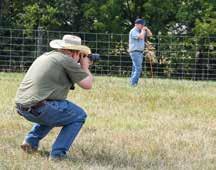
Chism stressed the importance of a clear, uncluttered background focused solely on the subject, ensuring attention remains squarely on the cattle. Practical tips, such as the optimal pen size, surface conditions, as well as the grass height, were shared to facilitate smoother photography sessions.







Matt Woolfolk, American Shorthorn Association
The final day of Summer Symposium kicked off a morning of data discussion with the announcement of the next generation of selection index offering from the American Shorthorn Association. A presentation of what Shorthorn breeders can expect in the coming days was led by ASA Director of Performance Programs Matt Woolfolk. The changes that will be implemented include:
- Modifications to $Feedlot formula to emphasize the market signals of increased carcass weight and quality grading
- Re-branding of $BMI to Balanced Merit Index to best depict the proper utility of the index
- Unveiling of the Cow Productivity Index, a maternal-trait focused selection metric
Woolfolk walked breeders through the three-year process of how ASA staff and leadership arrived at the announced modifications, including test runs on over 5,000 head of Shorthorns, a breeder review period, and a third-party audit conducted by Dr. Troy Rowan of the University of Tennessee. Plans are for the changes to be included in the genetic evaluation run conducted the week of August 19.
The ASA Strategic Plan has a Core Strategy of “investing in research and development to enable breed improvement”. These changes to the index lineup are part of our duty to help breeders produce better Shorthorns for the commercial cattle industry.

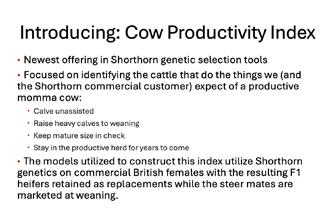


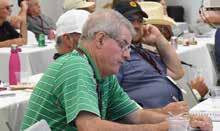
“As a breeder, having indexes that are more in touch with the needs of the breed (as compared to indexes that are more universal to any breed) should be a great tool for those who use them. These new indexes provide a current basis for reference and comparison that are in line with today’s economic environment and the ability to collect and manage information.”

Joe Bales, Tennessee






Dr. Scott Howard, Meyer Natural Foods
Saturday morning presented a session focused on the end product of the beef industry and how genetics play a role in carcass value. Notably, Dr. Scott Howard of Meyer Natural Foods focused on factors influential to carcass value, while encouraging breeders to use selection tools, such as genetics to earn merit at harvest time.
During the session, the discussion primarily revolved around three pivotal factors that significantly influence the quality grade:
1. Marbling: The intramuscular fat content, known as marbling, plays a central role in determining the quality grade of beef. Higher marbling scores are indicative of better quality and tenderness, directly impacting consumer satisfaction and market value.
2. Maturity: The stage at which cattle are harvested, influences the tenderness and flavor of the meat. Properly timed maturity ensures optimal taste and texture, aligning with consumer preferences and industry standards.
3. Chill Time: The duration between slaughter and chilling, known as chill time, affects meat quality by allowing
for proper aging. Adequate chill time enhances tenderness and flavor development, further enhancing the overall quality grade. Suggested chill time is a “weekend chill”, which can create a 5-10% quality increase when properly achieved.
Beyond quality, yield grade also plays a crucial role in optimizing profitability in beef production. Factors such as fat thickness opposite the ribeye, ribeye area adjustment relative to hot carcass weight, and percentages of kidney, pelvic, and heart fat are meticulously evaluated to determine yield grade. Each adjustment in yield grade directly impacts the quantity and value of retail cuts derived from each carcass.
Dr. Howard urged breeders to know that “Hot carcass weight and fat is extremely important after marbling” when it comes to yield grade.
Excess fat, while traditionally considered a marker of quality, can also pose inefficiencies across various resources within the beef industry, including water, energy, feed, and labor. Strategic management of yield grade not only enhances efficiency but also ensures sustainability in resource utilization.




Dr. Howard, a prominent figure in the session, highlighted several critical points that resonated with attendees:
• He emphasized the economic strategy of increasing cattle weight to mitigate expenses, suggesting a direct correlation between weight and



production efficiency.
• Dr. Howard underscored the significance of hot carcass weight in relation to marbling, stressing its pivotal role in achieving desired quality grades.
The insights from the session underscored that profitability hinges on maximizing pounds of high-quality meat per carcass. Selection strategies focusing on factors like hot carcass weight and ribeye area have proven instrumental in enhancing overall carcass quality and yield. Moreover, advancements in genetic selection and management practices continue to present opportunities for improvement, particularly in specialized populations such as calf-fed Holsteins.
In conclusion, the session highlighted the intricate balance between quality and yield in beef production. By prioritizing factors like marbling, maturity and efficient yield grade management, breeders and producers can optimize profitability while meeting consumer demands for high-quality beef products. As the industry evolves, ongoing research and innovation will undoubtedly shape future strategies for sustainable and efficient beef production.

Interested in learning more?
Watch Dr. Howard’s session by viewing the QR Code.

Brian McCulloh, Woodhill Angus
Gone are the days when a cow was only as good as the set to her hock, her fleshing ability or her udder quality. We live in a world that runs on numbers, and it is time to utilize the cow “numbers” too.
At the Summer Symposium, Brian McCulloh of Woodhill Angus discussed how he made EPDs work for his operation. “You can’t create value without information,” he said.
“You
McCulloh shared many pieces of wisdom with his fellow seedstock producers, emphasizing:
- The dangers of single-trait selection
- The importance of lifetime learning
- Communicating with customers year-round
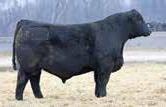


“Overnight success in the purebred cattle industry takes at least 15 years,” McCulloh remarked. A large part of Woodhill Angus’ success was their ability to collect, share and explain data to their customers, a position which McCulloh believes every seedstock producer should be in. During the session, McCulloh displayed a page of his bull sale catalog and explained to the group the data available, while encouraging breeders to sit down with their customers at sale time to do the same. An example of that page is shown below.
In the 21st century we have moved past phenotypic evaluation alone. It is time to not only use the data, but to teach the data.






A seedstock producer, a livestock market owner and a veteran sale manger…three unique perspectives with one resounding message. Communicate.
The last panel session focused on developing and cultivating your market with Jim Akers, Bluegrass Stockyards; Brian McCulloh, Woodhill Angus; and Dale Stith, Stith Marketing Service. The panel shared experiences, discussed challenges and offered seasoned advice on how to develop and cultivate a market for cattle. The thoughts shared can be widely applied regardless of operation size, location or end customer.
• Communicate everything you can to add value to your cattle (sire, weights, health records, etc.). This requires you to write things down.
• Regardless of where you’re selling, present cattle in a good way. For example, pick out sale cattle early

enough that you can feed them longer rather than feeding them more. Also, utilize a quality photographer so your catalog doesn’t disinvite people to attend your sale.
• Never let a problem get out the door. Instead deal with issues immediately.
• Establish an open line of communication the day of the sale, follow up post sale and talk about things you can do to help your customer get a better experience and follow up after calves hit the ground.
• Don’t forget about your neighbors as customers.
• If you wouldn’t buy it, don’t sell it and don’t sell problems.
• The sale ring is the signal of the decisions you make based off the price received. If you don’t receive a good price, be part of the improvement


process to get cattle to the top of the market.
• You’ll find new customers by taking care of an old customer.
The final word shared on market cultivation - put in the effort, use creativity and don’t be afraid to try.
Thank you, to our panelists and other speakers for providing our breeders and industry enthusiasts with such knowledgeable information and tips to improve their herd and business marketing strategies.

On the last day of the first ever Shorthorn Summer Symposium, we went on breathtaking tours, visiting both Claiborne Farms and Fasig-Tipton Sale Barn. We dug deep into the rich history of both facilities and learned about the horse industry in Kentucky.
In the heart of horse country, Claiborne Farm was established in 1910 by Arthur B. Hancock, Sr. in Paris, Kentucky. It has since become one of the most influential breeding operations in the United States. The farm has produced numerous champions and influential bloodlines in Thoroughbred racing. Some of the most famous include Bold Ruler, Secretariat, and more recently, Blame and Orb. Perhaps the most famous horse associated with

Claiborne Farm is Secretariat, who won the Triple Crown in 1973 with recordbreaking performances in the Kentucky Derby, Preakness Stakes, and Belmont Stakes. The farm’s breeding practices and stallions have had a profound impact on the Thoroughbred industry worldwide, shaping the sport and the breed itself. Claiborne Farm continues to be a leader in the industry, breeding and raising top-quality racehorses that compete at the highest levels of racing. Overall, Claiborne Farm’s rich history is intertwined with the history of American horse racing, marked by legendary horses, influential bloodlines, and a commitment to excellence in breeding.
Fasig-Tipton sale company was established in 1898 making it one of



North America’s oldest Thoroughbred auction companies. Its first headquarters were in Madison Square Garden in New York, and Fasig-Tipton initially sold highclass road and carriage horses in addition to Thoroughbred and Standardbred racing stock. With additional training, sales started in California, Maryland, Kentucky, Louisiana, and Florida. We learned about their fall yearling sale, which is a black-tie function. The vast number of prize-winning horses that have walked in and out of those doors was astonishing, to say the least. If you ever get the chance to visit, be sure to check out their wall of champions.

Cassie Reid
Elizabeth Crumm, Intern
Heather Lange
Kassidy Schumann, Intern
Matt Woolfolk
Paige Van Dyke, Intern
Shelby Diehm
Wade Minihan
Find videos of each speaker by scanning the QR Codes or by visiting the Shorthorn YouTube Channel @ShorthornASA.

Thank you to Merck Animal Health for sponsoring this Symposium review.

Cary Gilman, Iowa
Greg Beckler, Ohio
Joe Bales, Tennessee
Kevin Ferguson, Tennessee
Neal Smith, Indiana
Rick Leone, Colorado

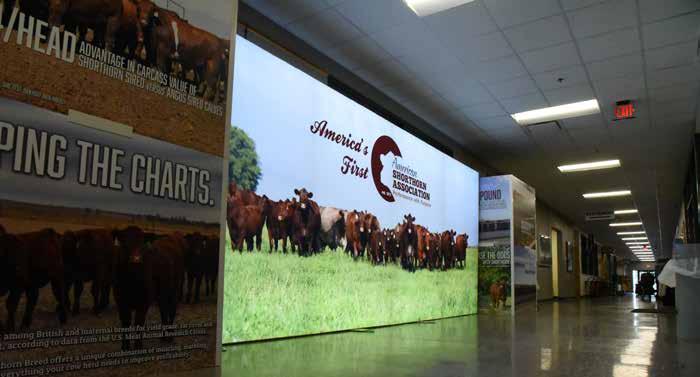


BOVILIS NASALGEN 3-PMH is the first and only intranasal vaccine that protects against IBR, BRSV, PI3 , Pasteurella multocida and Mannheimia haemolytica
It’s safe to use in calves 1 week of age and older for a strong, healthy foundation. And a unique BluShadow® diluent means there’s no secondguessing which animals have been vaccinated.

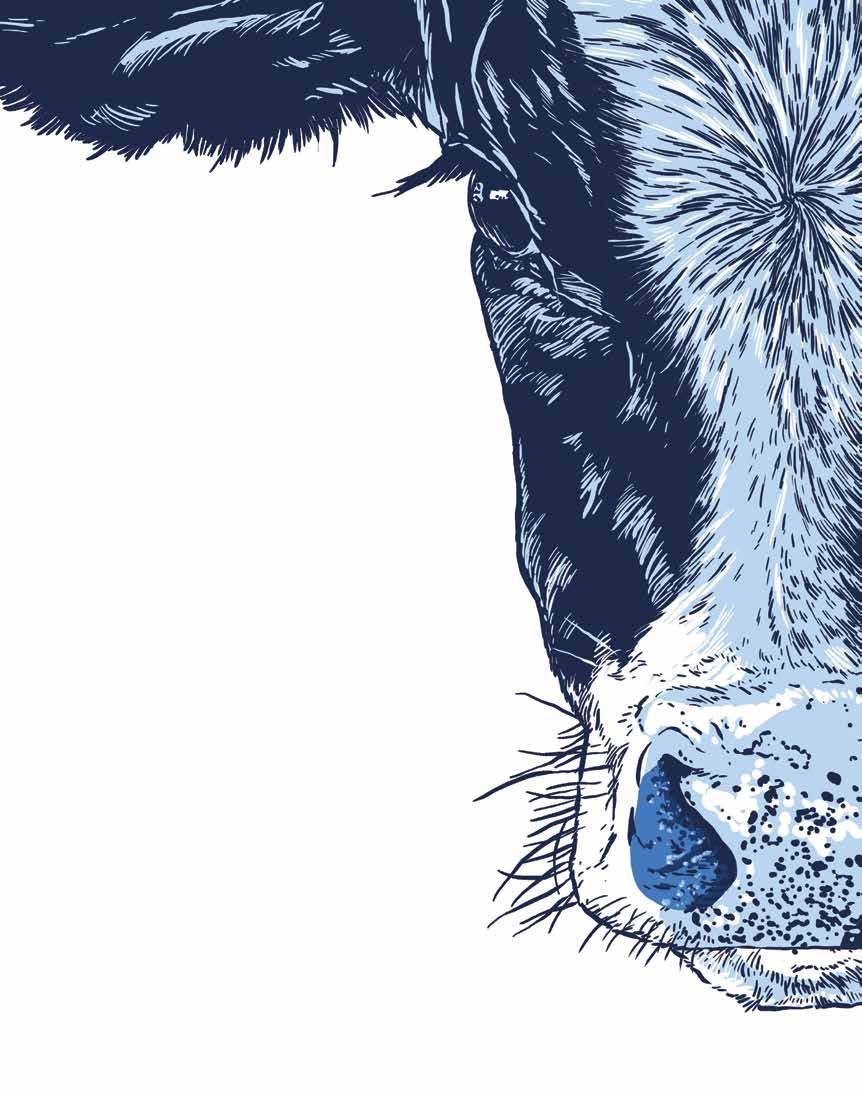



At the beginning of August, I attended the Agricultural Media Summit in downtown Kansas City. This is the largest gathering of ag media professionals in the country, and I attend each year for education, networking, and professional development.
The first night was the ‘famous welcome party’ where old and new friends gathered to catch up before we got busy with education. The next morning, we kicked off the event during breakfast with several speakers who discussed ‘Managing Risk and Creating Resiliency in Animal Health.’ Attendees joined in on the discussion with small groups to share how ag media professionals can help during animal health crisis.
After the introduction, we headed to different breakout sessions. The first one I attended was taught by Sweet Briar Creative owner, Alyssa Scholz Walsh. This session included tips for digital illustration and graphic design. She discussed her process for creating logos and brand guides. She encouraged attendees to look outside of ag for inspiration.
The next session ‘Confidence and Credibility in Networking’ was led by Marlene Eick of Ohio Farm Bureau. She has a background in leadership training. She discussed leadership types and levels as well as sharing how to make introductions in all different scenarios. The information I learned will be beneficial to my role as junior activity director. I hope to get Marlene to speak at the IGS Summit Conference next summer.
After the student luncheon and announcement of special scholarships, I attended the session ‘Creating Marketing Pieces that POP,’ by Taylor Gazda. She shared many ways she finds inspiration when designing and how to make sure your designs will be recognized.
The last session of the day was a keynote session by the Peterson Farm
Brothers. They are known for their parody music videos that promote agriculture. They even performed a few of them in person! It was interesting to learn more about how they started and have grown to promote agriculture across the US and in several countries.
That evening the Livestock Publications Council had a 50th Anniversary Celebration and several recognizable industry professionals were in attendance. It was a fun event to network and learn more about the history of LPC.
On Tuesday morning, attendees broke off into their affiliated groups for business meetings. As a member of Livestock Publications Council, I attended the LPC business meeting. We approved minutes from the last minute, heard about proposed by-law changes and committee updates. They also presented the nominations for board members. I was one of the nominations and will serve a three-year term as an LPC Board Member. After the meeting adjourned, we moved into the LPC awards, this includes recognizing different award categories that are judged. Categories included PR campaigns, catalogs, photographs, websites, articles and more! As part of the awards committee, I announced all these awards while other committee members helped our award sponsor, Modern Litho, handout the awards. After the meeting I signed up for several committees again.
This year the AMS Banquet was a luncheon, and all the special awards were announced while we enjoyed our last evening together. It is amazing to recognize special people at the banquet. I was asked to announce all the special awards this year.
We had a few more sessions that afternoon, I enjoyed the session about ‘branding.’ The panel shared that it is okay to sometimes ‘break the rules’ of branding guidelines if it will be the
design that will push the brand over the edge for recognition.
On Wednesday, I met with the rest of the steering committee to discuss how AMS went with the many changes we implemented. We discussed the peaks and valleys and suggestions for the next steering committee. I truly enjoyed getting to work on the committee and learning what goes into AMS each year. It was a lot of work with Zoom meetings each month and many emails, but I look forward to the opportunity to serve again.
Each year I attend AMS, I enjoy seeing old friends and making new ones. It is a great networking event and I have grown in the last several years personally and professionally. I look forward to continuing my involvement with LPC and attending this event. Next year it will be in Rogers, Arkansas!

Announcing Awards





Hopefully, by the time this issue reaches your inbox, you have seen the changes to our selection index offering implemented in Digital Beef. If it’s your prerogative, you’ve taken the time to study how the changes to the $Feedlot formula are reflected in your herd, as well as the addition of the Cow Productivity Index (CPI). As the new index on the page, there’s undoubtedly questions about how it works. This article will walk through some of that aiming to give you a better understanding of CPI.
Let’s start with the breeding objective that defines CPI and, thus, the traits that get included in the model. This index mirrors the production scenario in which Shorthorn genetics are going to be most often utilized in the commercial sector: to produce own replacement heifers and steers that are a payday for their producer as feeder calves. As seedstock producers, we have been told over and over that the commercial cattleman wants cattle that don’t cause them problems, most recently by panel members Brian McCulloh, Dale Stith, and Jim Akers at Summer Symposium. Either that mantra is truly so important that it must be repeated, or we aren’t doing a very good job of it, so they must keep telling us. The goal of CPI is to help identify those genetics that we might classify as less apt to cause problems: calve on their own, raise a good calf to the weaning pen, keep doing it year after year without getting bigger cows than a rancher might want.
With that in mind, the traits that fit this index according to the economic model are described below:
Calving Ease Direct (CED) - It’s no secret that the first key to having a profitable calf is getting it into this world safe and alive. The CED EPD is a prioritized part of CPI for that reason.
We don’t want calving issues, and neither do our customers.
Weaning Weight (WW) - The end marketing point utilized in the building of CPI is selling calves by the pound as weaned feeders. Obviously, that makes weaning growth genetics a significant component of CPI.
Yearling Weight (YW) - The YW EPD is included in CPI as the indicator trait of mature cow size and is weighted negatively in the index. While a genetic tool for cow weight is in the works at IGS (our genetic evaluation service provider), it is not available for use in our evaluations yet. Genetic studies have shown the correlation between yearling weight and mature weight to range from 75 to 85%. Of note, our BMI formulation has been put together in this same way since its inception, with YW being a negatively weighted part of that index as an indicator for moderating mature cow size as well.
Milk - Cows need to be able to produce enough milk to raise a healthy calf. While our hardest EPD to track, MILK is an important EPD in maternal selection. Too little MILK can leave you disappointed in your cows’ production. We also know that too much MILK can be an issue if you do not have the environmental resources to support heavier milking cows. The MILK EPD is included in a positive weighting in CPI.
Calving Ease Maternal (CEM) - If the goal is producing daughters that can go to work as productive cows, then they need to be able to have their first calf with no troubles. With that in mind, CEM is a part of CPI, albeit the least emphasized of the incorporated traits.
Stayability (STAY) - Longevity is a key to profitability for a cow. The longer
she produces, the better chance she becomes a moneymaker for you. STAY is our genetic measure of the likelihood of staying in production longer, meaning a higher STAY EPD is predicting a higher chance of hanging around the herd. The STAY EPD is a significant component to CPI’s formulation.
Several times, I have been asked about why specific traits were not included in CPI or weren’t weighted differently. I reference a chat I had with Dr. Troy Rowan as he performed a third-party analysis of CPI where we talked about a “desired gains” index: putting things into an index to make the outcome what we want it to be, without it necessarily fitting the economic models geneticists use to build the index. Instead, Dr. Rowan advocates for selecting for specific EPDs that might not fit into the index alongside of index selection to make genetic progress. If you want to improve marbling or ribeye or any trait with an EPD while still looking at CPI, you can certainly do that by studying that data in conjunction with the CPI index.
A presentation from Dr. Matt Spangler of University of Nebraska during this summer’s BIF Symposium analyzed this topic well, and I encourage you to look it up on www.beefimprovement.org if you are one of those folks who is lucky enough to have free time. His topic was discussing the challenges of selection indexes for producers who don’t market cattle on a carcass quality grid (many indexes utilize this as an endpoint in the index models). In his presentation, Spangler laid out two scenarios and created indexes for them, with the objective in both of keeping replacement females: a “sell steers at weaning index” with EPD selection thresholds for carcass traits (EPDs not included in the index),
and a “sell steers on the grid” index with no extra selection pressure for carcass (carcass EPDs were included in index).
The results of his trial were that the index that marketed cattle on the grid pointed him in the right direction for maternally oriented cattle but referred to it as “sub-optimal”. His test was better able to identify them via his sell at weaning index with selection pressures on carcass traits to. With my curiosity now peaked, I applied some of his tactics to our test population of sires for CPI. The chart to the right shows the average CPI for the top 50 bulls that also meet an EPD selection threshold. So, the top left value in the chart would be the average CPI of the top 50 CPI bulls in our test group that also are average or better for their MARB EPD. The top right box makes a stricter selection, cutting the MARB candidates to the top 25%. The same process is carried out for the other 3 EPDs on the table.
As expected, the more intense we make our selection criteria, we potentially sacrifice genetic merit as valued by the


index. However, if we are willing to give up a little to apply that selection pressure on other traits, bulls that excel for CPI, carcass, and/or growth are out there to use.
There’s a lot to unpack any time that a new selection tool is introduced, and
CPI is no different. Educating yourself on the available tools will always be important. Knowledge is power, and with knowledge of the tools that best suit your operation, your power to breed and improve Shorthorn cattle increases.
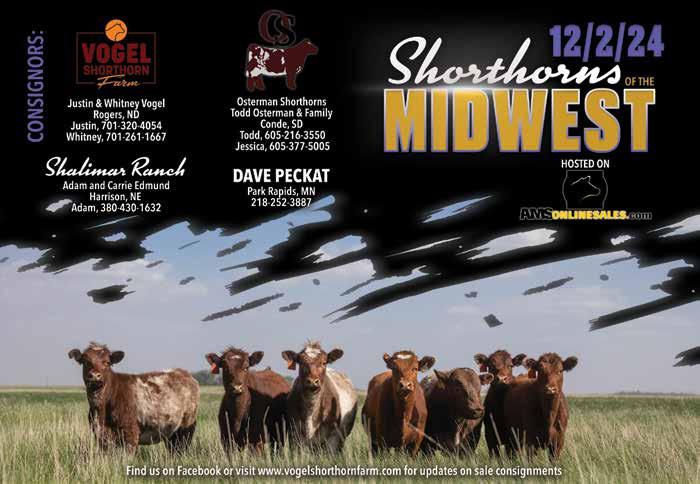

While summer doesn’t officially end until September 22 for most of us “summer” has come to an end. Students have returned to classes, fall calves are beginning to arrive, and here in the South we are getting ready for fair season. For the junior board, our end-of-summer meeting was held at the Summer Symposium in Lexington, Ky. We spent several days alongside ASA members and breeders focusing on “Putting your Herd in the Winner’s Circle”. In addition to some very intriguing and educational lectures, attendees toured Castle & Key Distillery, Blue Grass Stockyards, Boyd Beef Cattle, Clairborne Farm, and Fasig Tipton Thoroughbred Sales. Eastern Kentucky was a beautiful location for the Summer Symposium. I’d like to encourage all junior members to take advantage of these educational opportunities whether it’s an event like this provided by ASA or
local events through 4H, FFA, or your state organizations.
The junior board wrapped up the weekend in Kentucky by reflecting on our time Sailing Away in Maryland and coming up with ideas of how Groovy we can get in Grand Island. The junior board strives to continue the legacy of Shorthorn being the most enjoyable Junior Nationals. The junior board loves to hear from our exhibitors about what they enjoy about the NJSS. Be sure to reach out to us if you have questions or suggestions.
In closing, I would like to say thank you to the junior delegation for electing me as director. It is an honor to be the first Alabamian to wear a red coat. For this upcoming year, I look forward to seeing old friends and meeting new ones as I travel to the National Shorthorn Shows, and of course the 2025 NJSS in Grand Island, Nebraska.


President :: Haylee Ferguson
Vice President :: Brayden DeBorde
Secretary :: Amanda Smee
Public Relations :: Mackenlee Evans
Fundraising :: Hannah Wetzel
Director :: Samantha VanVorhis
Director :: Audrey Robertson
Director :: Jay Allen
Director :: Victoria Thompson
2025 • Grand Island, NE
2026 • Abilene, TX
2027 • Madison, WI
2028 • Louisville, KY
“Wisdom comes from making mistakes, having the courage to face them, and make adjustments moving forward based upon the knowledge aquired through those experiences. ”
Northeast Region – 77 head – Judge: Charlie Boyd
byCassieReid




Grand Champion
Shorthorn Bull, Maximum Payday 1206 exhibited by Cooper Hetrick, Fremont, Ohio.
Grand Champion
Shorthorn Female, SULL LFG Knights of Ruby 3400 ET exhibited by Kolten Greenhorn, Bellbrook, Ohio.
Reserve Grand Champion
Shorthorn Bull, 4CSC Metallika exhibited by Alyssa Carter, Oregonia, Ohio.
Reserve Grand Champion
Shorthorn Female, CF Max Rosa 3138 ET exhibited by Samantha VanVorhis, Bowling Green, Ohio.
Grand Champion
ShorthornPlus Bull, SVV Storm Front 1824 ET exhibited by Samantha VanVorhis, Bowling Green, Ohio.
Grand Champion
ShorthornPlus
Female, CF Proven Queen 2125 EV X ET exhibited by Samantha VanVorhis, Bowling Green, Ohio.
Reserve Grand Champion
ShorthornPlus Bull, JSF KANE Eastwood 67L ET exhibited by Brennstuhl Farms LLC, Butler, Ohio & Aegerter Cattle Company, Seward, Neb.
Reserve Grand Champion
ShorthornPlus
Female, B/R Dream Lady P233ET ET exhibited by Caiden Roberts, Cumberland, Ohio.
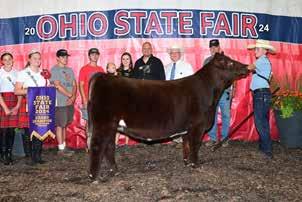



June 9, 2024 - Dodge County Fairgrounds, Beaver Dam, WI

Reserve Champion Shorthorn
- KRS Dollie 49 - Brooklyn Duchatschek
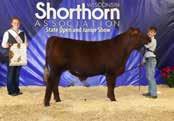
Champion Bred and Owned Shorthorn Steer - Sonny - Hank Pfaff

Champion Shorthorn HeiferCAS Strawberry 48L - Brooklyn Duchatschek
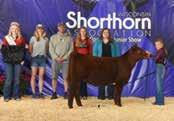
Reserve Champion Shorthorn Heifer - AF VF Carrie Jane 317 - Joslyn Bishell

Champion Shorthorn Cow/Calf Pair - CAS Quinn - Jackson Britzke

Champion ShorthornPlus Heifer - MFS Dreaming Oreo 8L ETKelsey Kuehni
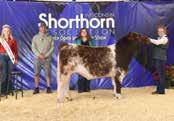
Champion Shorthorn Bull and B&O - BISH OFS Lone Wolf 313 BS ET - Catelyn Olsen

Reserve Champion Shorthorn Bull and B&O - TAG Off the Record - Abby Giddings




Champion Bred & Owned Shorthorn Heifer - BLSC Elizabeth R1L - Kelsey Kuehni

Reserve Champion ShorthornPlus Heifer - TKA Flo Nellie - Rahfi Pfeuti

Reserve Champion Bred & Owned Shorthorn Heifer - CAO Rosemary’s Lavender - Catelyn Olsen
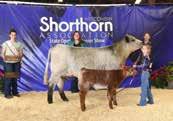


June 9, 2024 - Dodge County Fairgrounds, Beaver Dam, WI
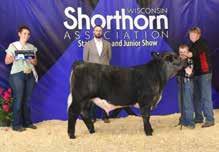
Champion ShorthornPlus Bull - CAS Evan - Cheerful Acres

Reserve Champion Shorthorn Bull - TAG Off the Record - TAG Livestock

Champion Shorthorn Cow/Calf PairCAS Quinn - Cheerful Acres

Reserve Champion ShorthornPlus BullJC Walter Ronan Storm - JCWalter Farm

Champion ShorthornPlus Heifer - TKA Flo Nellie - Pfeuti Land and Cattle
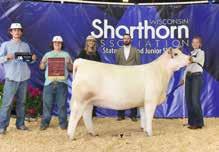
Champion Shorthorn Heifer - RJC Lady Crystal 377L ET - C5 Farms
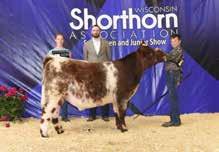
Champion Shorthorn Bull - BJSF Captain’s Dream 3674 - Signature Farms

Reserve Champion ShorthornPlus Heifer - MFS Dreaming Oreo 8L ET - Kelsey Kuehni

Reserve Champion Shorthorn HeiferCAS Strawberry 48L - LB Livestock
Picture Not Available: Champion ShorthornPlus Cow/Calf Pair - TSR Outsider’s Gemstone - Twisted S Ranch
June 13, 2024 - Plainview, TX • Judge: Nick Fitzsimmons, OK
Champion Shorthorn Heifer - TCP Bergie’s Lookin Ruby 25-2L - Piper Carr, Littlefield, TX Reserve Champion Shorthorn Heifer - S/N Dream Lady Lana 310 ET - Chloe Carlisle, Amarillo, TX


Reed Gregory Satterfield was proudly welcomed on March 31, 2024 by Matthew and Hayley Satterfield of Haylo Farms, Dawsonville, Georgia. Reed is joining his two older brothers Tate and Colt at home. The family looks forward to his future in and out of the show ring! Hilton Kansas City Airport 8801 NW 112th
$119/night
Reservation Cut-Off: Noon, Thursday, October 3, 2024
https://shorthorn.org/annual-meeting/

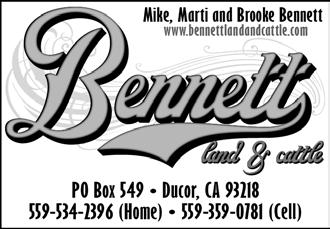




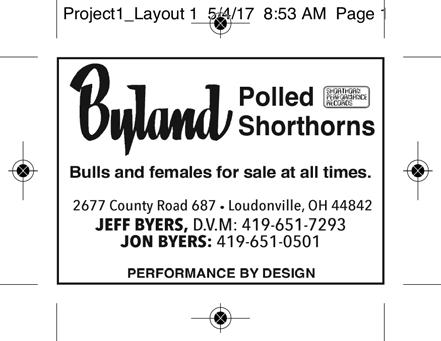









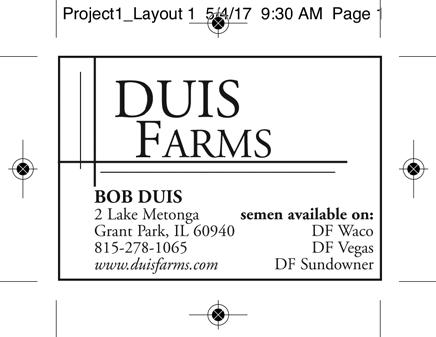




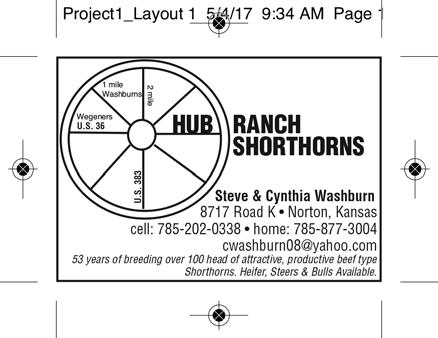






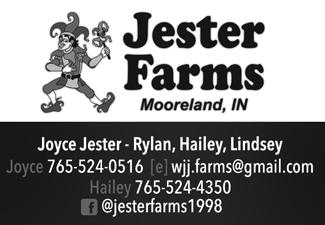


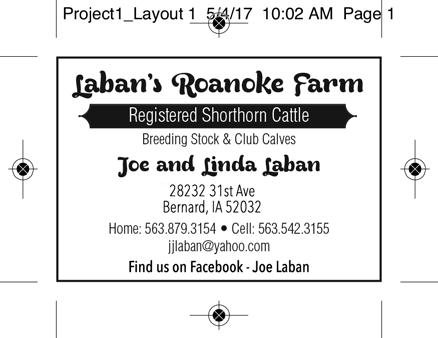





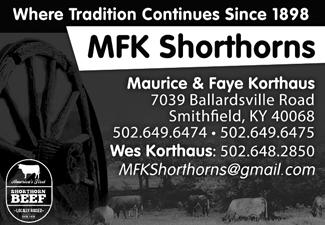





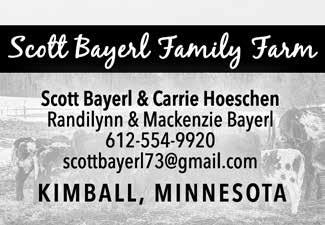













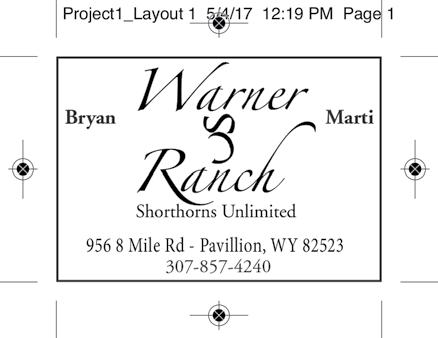









Sept. 1 - R-C Show Cattle “Early Bird” Online Sale and Open House, Eaton, Ohio, sconlinesales.com
Sept. 1 - Turner Shorthorns “Somerset Sensations” Open House and Private Treaty Sale, Somerset, Ohio. amsonlinesales.com
Sept. 8 - Schaeffer Tice “Elite Heifer Sale” Telephone Bid-Off, Hagerstown, Ind.
Sept. 9 - Berg’s Shorthorns Online Sale, Osage, Iowa, amsonlinesales.com
Sept. 9 - Smith Family Farms “Cattlemen’s Cut Online Sale”, Pendelton, Ind., amsonlinesales.com
Sept. 10 - Wasinger Cattle Company Online Sale, Winnebago, Minn., sconlinesales.com
Sept. 11 - Bonnell Cattle Co Online Sale, Columbus, Ind., sconlinesales.com
Sept. 11 - Gypsy Creek Ranch, Cattle Battle Online Sale, Gettysburg, PA, amsonlinesales.com
Sept. 15 - Farrer Stock Farms “51st Annual Sale of Champions”, Royal Center, Ind.
Sept. 15 - 6B Farms “Ladies Night Out” Online Sale, Allison, Iowa, sconlinesales.com
Sept. 17 - Moore Shorthorns Show Heifer Online Sale, Jerseyville, Ill., amsonlinesales.com
Sept. 18 - ShowMax Cattle Co Online Sale, Utica, S.D., sconlinesales.com
Sept. 21 - Shadybrook Farms “Decades of Excellence” Production Sale, West Brome, Quebec, Canada. Sept. 22 - Steck Cattle “Our Commitment Bid-Off Sale”, Woodstock, Minn.
Sept. 23 - Leemon Cattle Company “Banners and Bloodlines” Online Sale, Fairland, Okla., Sept. 28 - The Great Shorthorn Revival, Beaverton, Mich.
Oct. 1 - Cagwin Farms 1872 + Can’t Stop Opportunity Sale, Virginia, Ill., amsonlinesales.com
Oct. 5 - Greenhorn Cattle Co “Where Great Females Make A Difference” Production Sale, Waynesville, Ohio.
Oct. 7 - Bollum Family Shorthorns “Red White and Roan” Online Sale, Goodhue, Minn., amsonlinesales. com
Oct. 8 - Tadmore Farms Heifer and Genetic Sale, Caldwell, Texas, sconlinesales.com
1/4
1/6
* To have your sale listed in the sales calendar, you must be an advertiser with the Shorthorn Country.

Aegerter Marketing Services, Inc. Jeff K. & Darla Aegerter 402.641.4696 - jeff.aegerter@gmail.com www.aegertermarketing.com
Sept. 16 - Jester Farms “No Foolin” Sale, Mooreland, IN, amsonlinesales.com
Oct. 8 - S Co Shorthorns “Minnesota Made” Elite Multi Breed Online Sale, Hastings, Minn., amsonlinesales.com
Oct. 10 - Nelson Farms Maternal Icons Show Heifer & Genetic Online Sale, Seneca, Ill, amsonlinesales.com
Oct. 12 - Studer Family Shorthorns, “Family Legacies” Production Sale, Anita, Iowa.
Oct. 12 - Schrag|Nikkel “Family Event” Sale, Marion, S.D.
Oct. 12 - “Heart of the Prairie” Production Sale, Rush Springs, Okla.
Oct. 13 - Ohio Shorthorn Breeders Assocaition Fall Showcase Sale, Millersburg, Ohio.
Oct. 14 - Hill Haven Shorthorns Selection Sale, Canada, amsonlinesales.com
Oct. 15 - Bonnell Cattle Co Online Sale, Columbus, Ind., sconlinesales.com
Oct. 19 - Bedwell Cattle Co and Lost Diamond B Ranch, “Lasting Impressions” Sale, Isabella, Okla.
Oct. 24 - Roanoke Farm Dispersal Sale, Bernard, Iowa, amsonlinesales.com
Oct. 27 - Six’s Shorthorns, “Legends of the Fall” Sale, Wind Ridge, Pa.
Nov. 2 - Jungels Shorthorn Farm, “Durham Nation” Production Sale, Kathryn, N.D.
Nov. 3 - DJS Shorthorns “The Showcase” 2024 Sale, Laurel, Neb.
Nov. 9 - Four State Shorthorn Association Sale, Diamond, Mo.
Nov. 17 - Greenhorn Cattle Co, “Where Future Generations Are Created” Sale, Louisville, Ky.
Nov. 24 - Farrer Stock Farms, “Annual Dynamic Dams” Sale, Royal Center, Ind.
Nov. 29 - Steck Cattle Divas & Donors “The Exclusive”
Dec. 2 - Vogel, Osterman, Shalimar + Peckat “Shorthorns of the Midwest” Sale, amsonlinesales.com
Dec. 10 - Gilman Shorthorns “Customer Appreciation Semen Sale”, Stuart, Iowa, amsonlinesales.com
Dec. 14 - Paint Valley Farms, Byland Polled Shorthorns, and Beckler Shorthorns “Maternal Event” Sale, Millersburg, Ohio.
Sept. 16 - Ridge Top Farms and Friends, Washington, PA, amsonlinesales.com
Sept. 17 - Moore Shorthorns Show Heifer Online Sale, Jerseyville, IL, amsonlinesales.com
Sept. 21 - Shadybrook Farms Production Sale, West Brome, Quebec, Canada
Sept. 23 - Leemon Cattle Company “Banners and Bloodlines” Online Sale, Fairland, OK, amsonlinesales. com
Sept. 24 - Shoufler Shorthorns Online Sale, Fortville, IN, amsonlinesales.com
Sept. 28 - Great Shorthorn Revival, Beaverton, MI
Oct. 1 - West Fork Ranch Club Calf Sale, Loup City, NE, amsonlinesales.com
Oct. 1 - Cagwin Farms 1872 Opportunity Sale, Virginia, IL, amsonlinesales.com
Oct. 2 - Millbrook’s Northern Exposure Volume IV, Brome, Quebec Canada, amsonlinesales.com
Oct. 2 - Oak Ridge Farms Sale, Logansport, IN, amsonlinesales.com
Oct. 5 - GCC “Where Great Females Make a Difference” Production Sale, Waynesville, OH
Oct. 7 - Bollum Family Shorthorns Red, White, & Roan Online Sale, Goodhue, MN, amsonlinesales.com
Oct. 8 - S Co “Minnesota Made” Elite Multi Breed Online Sale, Hastings, MN, amsonlinesales.com
Oct. 10 - Nelson Farms Maternal Icons Show Heifer & Genetic Online Sale, Seneca, IL, amsonlinesales.com
Oct. 12 - Crow Creek “Heart of the Prairie” Production Sale, Lawton, OK, amsonlinesales.com
Oct. 13 - Ohio Shorthorn Breeders Association Fall Showcase Sale, Millersburg, OH
Oct. 13 - 4 Spear Ranch “Roans in the Rockies” Sale, Casper, WY, amsonlinesales.com
Oct. 14 - Bishell/Nollswood Online Sale, Mineral Point, WI, amsonlinesales.com
Oct. 14 – Hill Haven Selection Sale, Duntroon, Ontario, amsonlinesales.com
Oct. 19 - Bedwell Cattle Co. & Lost Diamond B Ranch “Lasting Impressions” Sale, Isabella, OK
Oct. 20 - Gana Farms Show Heifer Sale, Martell, NE, amsonlinesales.com
Oct. 21 - Horns in the Heartland Sale, Syracuse, NE, amsonlinesales.com
Oct. 22 - Double G Shorthorns Online Sale, Hinton, OK, amsonlinesales.com
Oct. 23 - Schutz Cattle Company “Bred for Banners” Sale, Parkland County, Alberta, CA, amsonlinesales. com
Oct. 24 - Roanoke Farm Dispersal Sale, Bernard, IA, amsonlinesales.com
Oct. 27 - Six’s Shorthorns “Legends of the Fall” Sale, Wind Ridge, PA
Oct. 27 - 3 Buck Cattle Company Online Sale, Bryant, SD, amsonlinesales.com
Oct. 28 - The Encore presented by Cornerstone Farms, Winchester, IN, amsonlinesales.com
Oct. 29 - Missouri Shorthorn Association Fall Sale, amsonlinesales.com
Nov. 1 - Naylor Angus “Bred for Balance” Herd Sire Sale, Half Way, MO, amsonlinesales.com



What
Show Season: April 1, 2024 – March 31, 2025
*Individual show schedule subject to change
Northeast Region :: CT, DE, IN, ME, MD, MA, MI, NH, NJ, NY, OH, PA, RI, VA, VT, WV
National Show :: Keystone International Livestock Expo
Super Regional Show :: Maryland State Fair
Regional Shows :: Ohio State Fair & State Fair of West Virginia
Southeast Region :: AL, FL, GA, KY, MS, NC, SC, TN
National Show :: Dixie National
Super Regional Show :: Tennessee State Fair at Wilson County Fair
Regional Shows :: Appalachian Fair & Kentucky State Fair
North Central Region :: IL, IA, MO, MN, NE, ND, SD, WI
National Show :: American Royal
Super Regional Show :: Iowa State Fair
Regional Shows :: Minnesota State Fair & World Beef Expo
South Central Region :: AR, KS, LA, OK, TX
National Show :: Fort Worth Stock Show
Super Regional Show :: Tulsa State Fair
Regional Shows :: Kansas State Fair & Tri-State Fair
West Region :: AZ, CA, CO, ID, MT, NV, NM, OR, UT, WA, WY
National Show :: National Western Stock Show
Super Regional Show :: Northern International Livestock Exposition
Regional Shows :: Western Idaho State Fair & Washington State Fair
*Regional Awards calculated from Regional, Super Regional & National Shows within each region. Animal must exhibit at 2 of 4 shows to qualify.
Super National Shows :: 2 total
North American International Livestock Expo :: Louisville, KY Cattlemen’s Congress :: Oklahoma City, OK
National Shows :: 5 total, 1 in each region
Northeast :: Keystone International Livestock Expo :: Harrisburg, PA
Southeast :: Dixie National :: Jackson, MS
North Central :: American Royal :: Kansas City, MO
South Central :: Fort Worth Stock Show :: Fort Worth, TX
West :: National Western Stock Show :: Denver, CO
*National Show Bull & National Show Female points accumulated from 7 total National & Super National Shows listed above. Animal must exhibit at 2 of 7 shows to qualify for National Show Awards.


